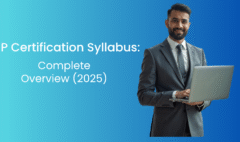How to Write a Project Plan in 8 Easy Steps (with Examples)
January 2, 2025 2025-01-03 14:39How to Write a Project Plan in 8 Easy Steps (with Examples)
A well-thought-out project plan is the foundation of any successful project. Whether you’re managing a small task or a large-scale initiative, a project plan helps you stay organized, set clear goals, and track progress toward completion. In this blog, we will take you through 8 easy steps to write a project plan and explain each step with examples. If you’re aiming to become a certified Project Management Professional (PMP), this guide will also help you understand the process of planning a project, which is a crucial aspect of the PMP certification exam.
Additionally, we’ll touch on the PMP certification cost in Chennai, the importance of best online project management certificate programs, and how they can help boost your project management career.
Why is a Project Plan Important?
A project plan acts as a roadmap that guides the project from start to finish. It defines the project goals, outlines the tasks involved, allocates resources, and sets deadlines. Without a detailed project plan, teams may lose track of objectives, deadlines, and budgets, leading to confusion, inefficiencies, or even project failure.
Creating a project plan is an essential skill for any project manager, and it’s something you’ll learn during a PMP certification program. With the knowledge gained from best online project management certificate programs, you’ll be better equipped to manage projects of all sizes.
8 Easy Steps to Write a Project Plan
1. Define the Project Scope and Objectives
Before you can start planning the individual tasks, you need to clearly define the project’s scope and objectives. This step helps you understand what is included and excluded from the project, and it provides clarity for all stakeholders.
Example:
Let’s say you’re planning a website redesign project. The project’s scope might include updating the website design, improving user experience (UX), and optimizing the website for mobile devices. The scope does not include content creation or any major backend development work.
- Project Objective: Improve website aesthetics and usability to enhance user engagement.
2. Identify Stakeholders and Resources
Next, identify the key stakeholders involved in the project. Stakeholders can include team members, clients, vendors, and anyone else who will have an impact on the project. You’ll also need to identify the resources required, such as people, tools, and technology.
Example:
For the website redesign project, stakeholders might include the project manager, design team, developers, content creators, and the client. Resources could include software tools for design (like Adobe XD), web hosting services, and a budget for development.
3. Create a Work Breakdown Structure (WBS)
A Work Breakdown Structure (WBS) is a visual representation of the project’s tasks, broken down into manageable components. This step involves decomposing the project into smaller, more manageable parts, which helps you clearly define all the tasks needed to complete the project.
Example:
For the website redesign project, a WBS might look like this:
- Design Phase
- Research competitors
- Create wireframes
- Develop prototypes
- Gather feedback from stakeholders
- Development Phase
- Front-end coding
- Back-end coding
- Integrate third-party tools
- Testing Phase
- Usability testing
- Mobile optimization
- Bug fixes
By breaking the project down in this way, it becomes easier to allocate resources and set timelines for each task.
4. Define Roles and Responsibilities
Once you have a clear understanding of the tasks involved in the project, assign roles and responsibilities. Each team member should know their specific responsibilities to avoid confusion and ensure accountability.
Example:
For the website redesign project:
- Project Manager: Oversees the project, ensures timelines are met, communicates with stakeholders.
- Design Team: Creates mockups, wireframes, and prototypes.
- Development Team: Writes the code and integrates the design with the backend.
- Quality Assurance (QA) Team: Tests the website for bugs and ensures quality standards are met.
Clearly defining roles at the beginning of the project ensures that everyone knows what they’re responsible for, which helps in avoiding conflicts and delays.
5. Set Milestones and Deadlines
To ensure the project stays on track, set clear milestones and deadlines for each task or phase. Milestones are significant achievements or checkpoints in the project that help you track progress.
Example:
For the website redesign project, milestones could be:
- Design Phase Completion: End of week 2
- Development Phase Completion: End of week 6
- Beta Testing Completion: End of week 8
- Project Completion: End of week 10
These milestones give the team a clear understanding of when each phase should be completed, helping to ensure that the project stays on schedule.
6. Estimate Budget and Resources
A crucial part of planning any project is estimating the budget and resources. This step includes estimating the cost of materials, tools, labor, and any other expenses that might arise during the project. It’s essential to allocate resources efficiently to avoid overspending and delays.
Example:
For the website redesign project, the budget might include:
- Design tools and software licenses: ₹50,000
- Development costs (labor): ₹2,00,000
- Marketing and testing: ₹30,000
- Miscellaneous costs: ₹20,000
Ensure that you have a buffer in case of unexpected costs, as projects often encounter unforeseen challenges.
7. Identify Risks and Mitigation Plans
Every project comes with risks, whether they are technical, financial, or related to resources. Identifying potential risks early on and developing mitigation plans is critical to minimizing disruptions.
Example:
For the website redesign project, possible risks might include:
- Risk: Delay in feedback from stakeholders, causing delays in the design phase.
- Mitigation Plan: Set clear deadlines for stakeholder feedback and schedule weekly check-ins to ensure timely responses.
- Risk: The website doesn’t work on mobile devices as expected.
- Mitigation Plan: Conduct early mobile testing and include mobile optimization as a priority in the design phase.
By planning for potential risks, you’ll be better prepared to handle issues when they arise.
8. Monitor Progress and Adjust the Plan
Finally, a project plan is a living document. As the project progresses, you should continually monitor its status and adjust the plan as necessary. This includes reviewing whether milestones are being met, whether the project is within budget, and whether there are any changes in scope.
Example:
If the design phase is delayed due to unexpected issues, you might need to extend the timeline for that phase and adjust the deadlines for the remaining tasks. If the development team finishes early, you can allocate more time for testing and feedback.
Monitoring and adjusting the plan regularly ensures that the project stays on track and any deviations are quickly addressed.
How PMP Certification Can Help
If you’re serious about managing projects effectively, pursuing PMP certification can enhance your project management skills. A PMP certification demonstrates your ability to manage projects from start to finish, covering aspects like scope, budget, risk management, and team coordination. It’s a globally recognized credential that is highly valued by employers.
PMP Certification Cost in Chennai
The PMP certification cost in Chennai can vary depending on the training provider and the resources included. Generally, the cost for PMP exam preparation courses in Chennai ranges from ₹30,000 to ₹50,000. This cost typically covers training materials, mock exams, and other resources to help you prepare for the exam. Keep in mind that there are also additional fees for the PMP exam itself, which is approximately ₹40,000 for non-members of the Project Management Institute (PMI).
Investing in PMP certification can significantly improve your career prospects and increase your earning potential as a project manager.
Best Online Project Management Certificate Programs
If you’re looking to start or advance your career in project management, there are many best online project management certificate programs available that can help you build the skills needed to plan and manage successful projects. Some of the best programs include:
- Coursera: Google Project Management Certificate
This course is designed for beginners and covers key project management concepts, tools, and techniques. It’s a great starting point for those looking to build a career in project management. - Udemy: Project Management Professional (PMP) Exam Prep
This course prepares you for the PMP exam and covers essential project management principles. It’s a comprehensive program that aligns with the PMI’s PMBOK (Project Management Body of Knowledge). - edX: Project Management MicroMasters Program by RIT
This is a more advanced program designed for professionals looking to deepen their project management knowledge. It covers topics like Agile methodologies, project scheduling, and risk management.
Conclusion
Writing a project plan is an essential skill for any project manager. By following these 8 easy steps, you can ensure that your projects stay on track, meet deadlines, and stay within budget. Whether you’re working on a small internal project or managing a large-scale initiative, a project plan is your roadmap to success.
Additionally, pursuing a PMP certification or enrolling in best online project management certificate programs can further enhance your ability to create effective project plans and advance your career in project management. If you’re located in Chennai, the PMP certification cost is an investment that will pay off with higher salaries, more job opportunities, and greater professional recognition.
Happy planning, and good luck with your projects!







